Hyperpigmentation Treatment Market Research, 2032
The global hyperpigmentation treatment market was valued at $5.1 billion in 2022, and is projected to reach $10.5 billion by 2032, growing at a CAGR of 7.5% from 2023 to 2032. The growth of the hyperpigmentation treatment industry is driven by an increasing awareness about skin care, high impact of social media on skin care and beauty standard and technological advancement in the hyperpigmentation treatment product to increase the effectiveness of the product. For instance, according to 2022 report by National Library of Medicine, it was reported that emerging pharmacological therapeutics include topical metformin, flutamide, isobutylamido thiazolyl resorcinol and platelet-rich plasma for the treatment of melasma and post-inflammatory hyperpigmentation. In addition, according to the World Health Organization, it was estimated that the number of elderly people (aged above 60 years) is expected to reach 2.1 billion by 2050. As individuals age, they are increasingly susceptible to various dermatological concerns, with hyperpigmentation being a prominent issue. Thus, the rise in geriatric population is expected to drive the growth of the market.
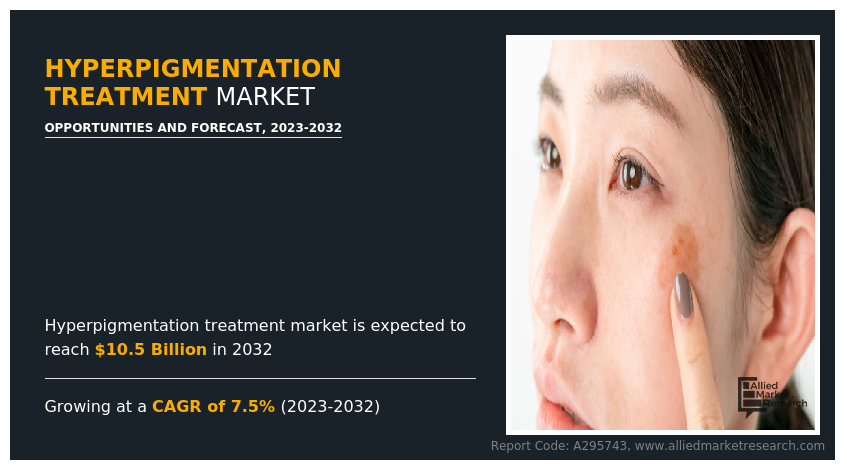
Hyperpigmentation refers to the darkening of the skin caused by the overproduction of melanin, leading to conditions such as melasma, post-inflammatory hyperpigmentation, and sunspots. The market for hyperpigmentation treatment includes a diverse range of products and procedures, ranging from topical creams containing ingredients such as hydroquinone, retinoids, and botanical extracts to advanced laser therapies and chemical peels.
Key Takeaways
- By treatment type, the topical agents segment dominated the hyperpigmentation treatment market share in 2022.
- By disorder type, the melasma segment dominated the global market in 2022. However, the age spot segment is expected to register the highest CAGR during the forecast period.
- By end user, the dermatological clinics segment dominated the hyperpigmentation treatment market share in 2022. However other segment is expected to registed highest CAGR during the foreast period.
- By region, North America dominated the market in terms of revenue in 2022. However, Asia-Pacific is anticipated to grow at the highest CAGR during the forecast period
Market Dynamics
The hyperpigmentation treatment market size is expected to grow significantly owing to rise in awareness about skin care, high impact of social media on beauty standards, and technological advancement in the hyperpigmentation treatment products. The hyperpigmentation treatment market has experienced a significant surge in revenue, primarily attributed to the surge in awareness about skincare. In recent years, there has been a notable shift in consumer behavior, with an increasing emphasis on skincare as an essential aspect of overall well-being. According to the 2022 report by the National Library of Medicine, it was reported that global consumers perceive skincare as an important aspect during the pandemic, while the importance of makeup fell after the outbreak.
The awareness of skincare and makeup products has changed. The spread of the pandemic (SOP) has a positive impact on skincare products. Consumers are increasingly seeking out innovative solutions, such as topical creams, serums, chemical peels, and laser therapies, that promise to fade dark spots, even skin tone, and restore radiance. Moreover, the expanding range of skincare brands and clinics offering specialized treatments has contributed to the growth of the hyperpigmentation treatment market. Skincare companies and treatment providers have capitalized on this trend by developing and marketing innovative solutions targeting hyperpigmentation. Thus, the rise in awareness about skin care is expected to provide significant hyperpigmentation treatment market opportunity for growth.
In addition, the high impact of social media on beauty standards has led to people opting for skin tone and spotless skin which has resulted in increased demand for hyperpigmentation treatment products. Platforms like Instagram, Facebook, and TikTok showcase curated images that often emphasize flawless, even-toned skin, setting unrealistic expectations for individuals. As a consequence, the demand for hyperpigmentation treatments has surged, driven by the desire to attain the flawless complexion promoted on social media. Users, influenced by the digitally altered and filtered images, seek remedies to address pigmentation concerns and achieve the idealized beauty portrayed online. Thus, the impact of social media on beauty standards is expected to drive the growth of the hyperpigmentation treatment market size.
Furthermore, rise in geriatric population is expected to contribute significantly in the growth of the market. The aging process often leads to various skin concerns, such as age spots, sunspots, and uneven skin tone, contributing to the escalating demand for effective hyperpigmentation treatments. The elderly demographic is becoming increasingly conscious of maintaining a youthful appearance and addressing dermatological concerns, thus fueling the demand for advanced and targeted solutions in the hyperpigmentation treatment. According to the 2023 report by the National Library of Medicine, lasers can now be used to target pigment under the skin’s surface, without causing irritation or damage to the skin. As a result, problems such as age spots and sun damage can be treated without any negative consequences or discomfort. Thus, the rise in geriatric population is expected to contribute significantly in the growth of the market.
Moreover, according to the hyperpigmentation treatment market analysis technological advancement in hyperpigmentation treatment products is expected to drive the growth of the hyperpigmentation treatement market share. According to 2022 Journal of Nanoparticle Research, it was reported that nanotechnology can bring to some common hyperpigmentation active ingredients such as hydroquinone, arbutin, kojic acid, azelaic acid, and retinoic acid to improve their efficacy in treating hyperpigmentation. Nanoparticles, due to their minuscule size, possess unique properties that enable enhanced skin penetration and bioavailability. In the context of hyperpigmentation treatment, the use of nanoparticles allows for the precise delivery of active ingredients to the melanin-producing cells, such as melanocytes, ensuring a more targeted and efficient therapeutic approach.
Nanoparticles exhibit a high surface area-to-volume ratio, enabling them to encapsulate and protect therapeutic agents, preventing degradation and increasing stability. This characteristic is particularly advantageous in formulating hyperpigmentation treatment products, where the integrity of active ingredients is crucial for optimal efficacy. Moreover, the ability of nanoparticles to penetrate the skin barrier facilitates a more controlled release of therapeutic compounds, ensuring a sustained and prolonged impact on pigmentation irregularities. This precise delivery mechanism minimizes potential side effects and enhances the overall safety profile of hyperpigmentation treatment products. Thus, the technological advancement in the hyperpigmentation treatment product is expected to drive the hyperpigmentation treatment market growth.
Segments Overview
The hyperpigmentation treatment market is segmented on the basis of treatment type, disorder type, end user, and region. By treatment type, the market is classified into topical agent, photo therapy, and microdermabrasion. By disorder type, the market is divided into age spots, melasma, and others. By end user, it is segregated into hospitals, dermatological clinics, and others.
Region-wise, the market is analyzed across North America (the U.S., Canada, and Mexico), Europe (Germany, France, the UK, Italy, Spain, and rest of Europe), Asia-Pacific (Japan, China, Australia, India, South Korea, and rest of Asia-Pacific), LA (Brazil, Colombia, Argentina, and rest of LA), and MEA (GCC, South Africa, North Africa, and rest of MEA).
By Treatment Type
The topical agents segment dominated the global hyperpigmentation treatment market in 2022, owing to its lower cost and easy availability. However, according to hyperpigmentation treatment market forecast photo therapy is expected to register highest CAGR during the forecast period owing the high effectivity of photo therapy devices such as medical lasers in treating hyperpigmentation.
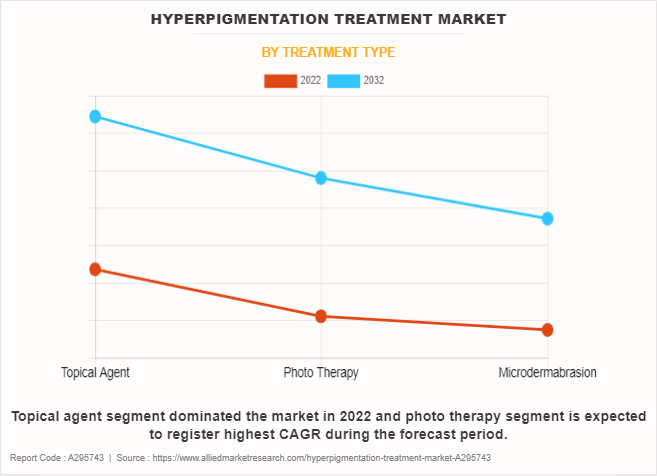
By Disorder Type
The melasma segment dominated the global hyperpigmentation treatment market share in 2022, owing to the high prevalence of melasma among the pregnent womens. However, the age spot segment is expected to register the highest CAGR during the forecast period. This is attributed to rise in geriatric population and increased participation in outdoor activities by peoples which increases the chances of sun damage leading to the hyperpigmentation.
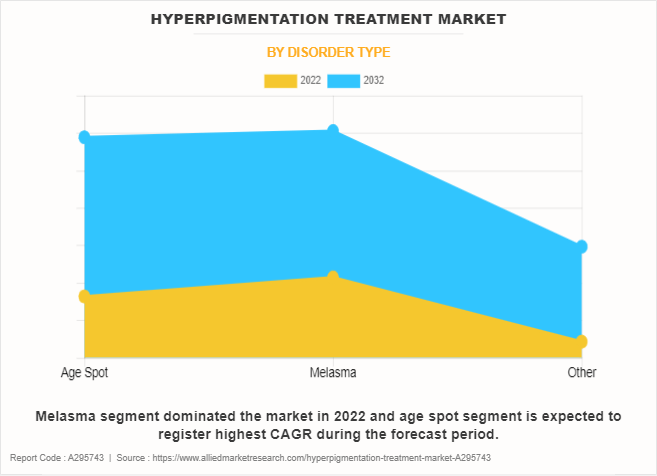
By End User
The dermatological clinics segment held the largest market share in 2022, owing to dermatological clinics typically offering a comprehensive range of treatment options for hyperpigmentation, including advanced laser therapies, chemical peels, and prescription medications. This diverse array of treatment modalities allows dermatologists to tailor their approaches to individual patients' needs, enhancing the efficacy of hyperpigmentation treatment. However, according to hyperpigmentation treatment market forecast analysis other segment is expected to register highest CAGR during the forecast period owing to rise in adoption of the home care laser and microdermabrasion devices for hyperpigmentation treatment.
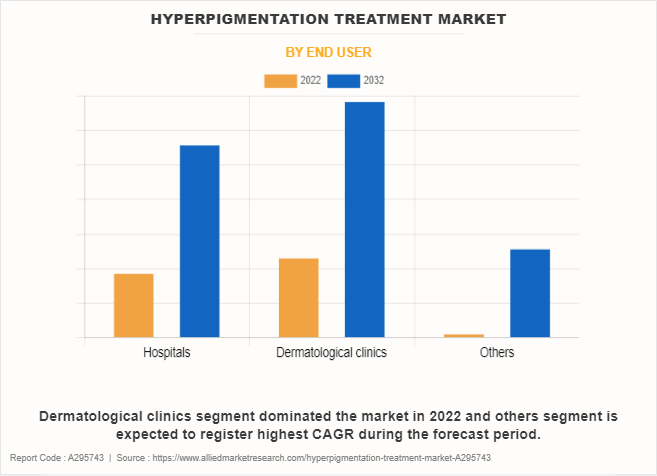
By Region
The hyperpigmentation treatment market is analyzed across North America, Europe, Asia-Pacific, LA, and MEA. North America accounted for a major share of the hyperpigmentation treatment market in 2022 and is expected to maintain its dominance during the forecast period. This is attributed to strong emphasis on skincare and aesthetics in North American culture, leading to a heightened demand for hyperpigmentation treatments and products. Moreover, advanced healthcare infrastructure and widespread access to dermatological services further drive the growth of the market in the North America region. The presence of leading pharmaceutical and skincare companies, coupled with robust research and development activities, fosters innovation and drives the introduction of new hyperpigmentation treatment options.
However, the Asia-Pacific Region is expected to register highest CAGR in the forecast period owing to the fact that Asia Pacific region encompasses densely populated countries with diverse skin types and skin tones, which inherently leads to a higher prevalence of hyperpigmentation concerns. Moreover, the rising disposable incomes and increasing consumer awareness regarding skincare and dermatological treatments drive the demand for hyperpigmentation treatments in this region.
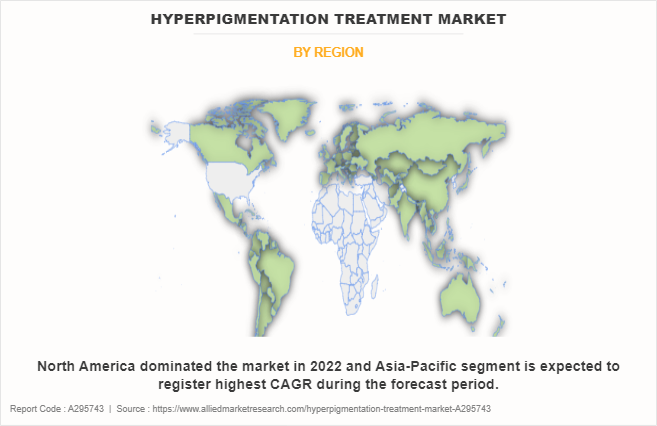
Competitive Analysis
Competitive analysis and profiles of the major players in hyperpigmentation treatment market, such as Episciences Inc, Vivier Pharma, Pierre Fabre S.A, L’Oréal Group, Areolase Corporation, Candela Corporation, SkinBase, EpiPharm AG, Galderma S.A., Alchemee LLC are provided in this report. Major players have adopted product launch as a key developmental strategy to improve the product portfolio of the hyperpigmentation treatment market.
Recent Development in the Hyperpigmentation Treatment Industry
- In January 2023, Allergan Aesthetics, an AbbVie company, announced the launch of the long-awaited SkinMedica Even & Correct Collection. Clinically proven and formulated to deliver targeted results, these three products work separately and together to even skin tone and reduce the appearance of hyperpigmentation and dark spots on the face.
- In February 2023, AMBI Skincare announced the launch of three new clinically studied, hydroquinone-free dark spot fade products. The Even & Clear Fade Cream, Even & Clear Fade Serum Retinol, & the Advanced Even & Clear Fade Cream will join the brand’s line of high-quality yet affordable skincare products for face and body, specifically formulated to provide smooth and even-toned skin.
Key Benefits for Stakeholders
- This report provides a quantitative analysis of the market segments, current trends, estimations, and dynamics of the hyperpigmentation treatment market analysis from 2022 to 2032 to identify the prevailing hyperpigmentation treatment market opportunities.
- The market research is offered along with information related to key drivers, restraints, and opportunities.
- Porter's five forces analysis highlights the potency of buyers and suppliers to enable stakeholders make profit-oriented business decisions and strengthen their supplier-buyer network.
- In-depth analysis of the hyperpigmentation treatment market segmentation assists to determine the prevailing market opportunities.
- Major countries in each region are mapped according to their revenue contribution to the global market.
- Market player positioning facilitates benchmarking and provides a clear understanding of the present position of the market players.
- The report includes the analysis of the regional as well as global hyperpigmentation treatment market trends, key players, market segments, application areas, and market growth strategies.
Hyperpigmentation Treatment Market Report Highlights
| Aspects | Details |
| Forecast period | 2022 - 2032 |
| Report Pages | 270 |
| By Treatment Type |
|
| By Disorder Type |
|
| By End User |
|
| By Region |
|
| Key Market Players | PCA Skin, Procter & Gamble, Bio Italica, Vivier Pharma, L’Oréal Group, Lyma, Trophy Skin, Pierre Fabre S.A, Episciences Inc, Areolase Corporation |
Analyst Review
This section provides various opinions of hyperpigmentation treatment market. The hyperpigmentation treatment market is expected to witness a significant growth owing to increasing awareness about skincare and aesthetic concerns, coupled with advancements in dermatological research and technology. However, high cost of photo therapy equipment and side effects such as skin irritation due to topical application products is expected to drive the growth of the market.
Furthermore, the research and development in medical aesthetics and dermatology has led to the development of multifunctional skincare products and combination therapies designed to address not only hyperpigmentation but also other common skin concerns such as acne, aging, and uneven texture. In addition, innovative treatment modalities for hyperpigmentation, ranging from topical creams and serums to laser therapies and chemical peels has experienced a surge in adoption.
Moreover, North America accounted for the largest share in 2022 and is expected to remain dominant during the forecast period. This is attributed to the strong presence of major key players, growth in aging population, has led to an increased demand for hyperpigmentation treatments, as aging often comes with skin-related issues such as sunspots and melasma. However, Asia-Pacific is anticipated to witness notable growth owing to rise in awareness of skincare and beauty standards in countries such as China, Japan, and South Korea, has fueled the demand for hyperpigmentation treatments. Moreover, increasing urbanization and changing lifestyles in emerging economies of Asia-Pacific have led to a surge in skin-related concerns, driving the market for hyperpigmentation treatments
The estimated industry size of hyperpigmentation treatment market in 2032 is $10.5 billion.
The base year is 2022 in hyperpigmentation treatment market.
North America is the largest regional market for hyperpigmentation treatment.
The forecast period for hyperpigmentation treatment market is 2023 to 2032.
The hyperpigmentation treatment market growth is attributed to changes in beauty standards globally, and surge in geriatric population.
Product launch is the key strategy adopted by the major players in hyperpigmentation treatment market.
The topical agents segment is the most influencing segment owing to its easily availability and cost efficiency.
Top companies such as Episciences Inc, Vivier Pharma, Pierre Fabre S.A, L’Oréal Group and Areolase Corporation, Candela Corporation held high market share in 2022.
Loading Table Of Content...
Loading Research Methodology...


